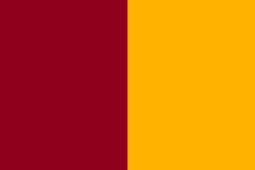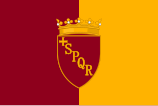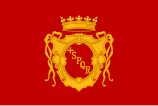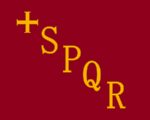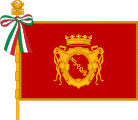
SPQR, an acronym for Senatus PopulusQue Romanus, is an emblematic phrase referring to the government of the Roman Republic. It appears on documents made public by an inscription in stone or metal, in dedications of monuments and public works, and on some Roman currency.
The Neapolitan Republic was a republic created in the Kingdom of Naples, which lasted from October 22, 1647, to April 5, 1648. It began after the successful revolt led by Masaniello and Giulio Genoino against King Philip III and his viceroys.

The civil flag of the Lublin Voivodeship, Poland is a tricolour rectangle, with three horizontal stripes: white (silver), red, and yellow (golden), with the coat of arms of the voivodeship, in form of the white (silver) malejumping cervus, with a yellow (golden) crown on its neck, placed on the red escutcheon, placed in the centre of the flag. The cervus is facing left. The top and bottom stripes are twice the size of the middle stripe.

The coat of arms that serves as the official symbol of the Masovian Voivodeship, Poland, consists of a red escutcheon, that features a white (silver) eagle, with raised wings, and its head turned left. Its current version had been designed by Andrzej Heidrich, and adopted in 2006.

The coat of arms of the Lesser Poland Voivodeship, Poland features a white (silver) eagle with a yellow (golden) crown on his head that is turned left, a beak, legs, and a stripes on its wings, with the charge placed on the red background. It was designed by Wojciech Drelicharz, Zenon Piech, and Barbara Widłak, and adopted in 1999.

The flag is the symbol of the city of Szczecin in West Pomeranian Voivodeship, Poland.

The flag is the symbol of the Subcarpathian Voivodeship, Poland.

The coat of arms of Kamień County, West Pomeranian Voivodeship located in Poland, is divided horizontally into blue and white stripes, with 2 golden (yellow) crosiers and 2 red roses within blue stripe, and red Griffin with yellow claws and beak, within the white stripe. The flag of the county is a rectangle divided horizontally into white and blue stripes, with the coat of arms in the middle.

The civil flag of the Lubusz Voivodeship, Poland is a rectangle divided into 4 stripes, which are, from top to bottom, yellow (golden), white, (silver), red, and green. Top and bottom stripes are twice the size of the 2 middle stripes. The state flag features the design of the civil flag, with the coat of arms of the voivodeship placed in the centre. It was adopted on 26 June 2000.

The coat of arms of Lubusz Voivodeship, Poland, features an Iberian style escutcheon divided vertically onto two sides, of which, the left side has red background, with left side of a white (silver) eagle, with yellow (golden) crown, legs, a ring on its tail, and a przepaska on its wing, while the right side, has green background with two yellow (golden) six-pointed stars, placed vertically. It was established in 2000.

The civil flag of the Łódź Voivodeship, Poland is a rectangle divided into five vertical stripes, which are altering between red and yellow colours. It was designed by Marek Adamczewski, and officially adopted on 25 June 2002.
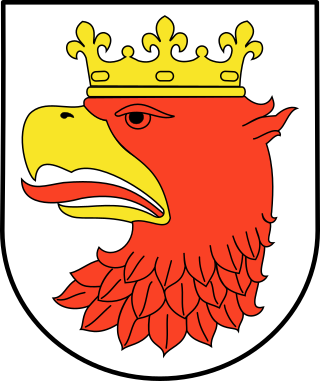
The coat of arms of the town of Police in West Pomeranian Voivodeship, Poland depicts the head of a red griffin with a yellow (golden) beak, and a yellow (golden) crown, place on the white (silver) background.

The coat of arms of the Łódź Voivodeship, Poland is an Iberian-style escutcheon with square top and rounded base. It is divided horizontally into three stripes (pales), that area from left to right: yellow (golden), red, and yellow (red), with the middle stripe being twice as big as the other stripes. It also include three charges placed in its center, with two placed next to each over, on the top of the third one. The top two charges are Kuyavian Hybrids, divided into half, into a lion and an eagle, while the bottom one is an eagle. It was designed by Marek Adamczewski, and officially adopted on 25 June 2002.

The flag of the Świętokrzyskie Voivodeship, Poland is a rectangle divided into four parts. Its left part features a yellow vertical stripe, which wight equals to 1:4 of the wight of the flag. Its right part is divided into three horizontal stripes, that are, from top to bottom: blue, white, and red. In the middle of the white stripe is placed the coat of arms of the voivodeship. The first version of the flag had been adopted in 2001, and current version is used since 2013.

The coat of arms of the Kuyavian-Pomeranian Voivodeship, Poland, consists of a white (silver) escutcheon, with a half of an eagle facing left, joined with a half of a lion facing right, both animals together wearing a yellow (golden) crown on their joined heads. It had been adopted in 2000.
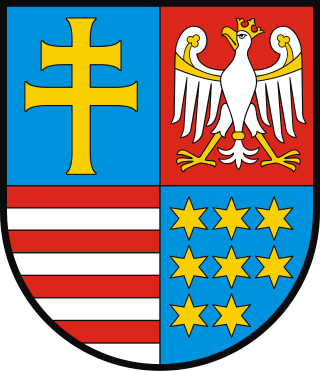
The coat of arms that serves as the symbol of the Świętokrzyskie Voivodeship, Poland, consists of the Iberian style escutcheon (shield), with square top and rounded base, that is divided in the 2 by 2 chessboard pattern. The top left field features a yellow patriarchal cross. The top right field features a white eagle with yellow crown, beak, legs, stripes on its wings, and a ring on its tail. The bottom left field features eight yellow six-pointed starts, placed in three rows, each with three stars, with the exception of the bottom row, that only had 2 stars, placed to the left.
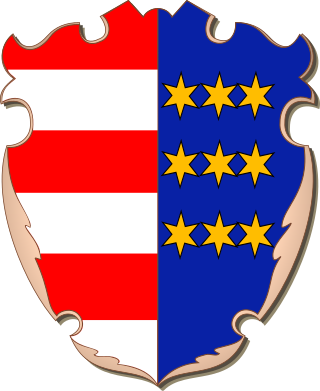
The historical coat of arms, that served as the symbol of the Sandomierz Land, and the Sandomierz Voivodeship of the Kingdom of Poland, from 14th to 18th centuries, was divided into two fields, with the left field consisting of six stripes, that were alternatining either between red and white, or red and yellow colours, and with the right field consisting of several yellow six-armed stars, which number altered between seven and nine.

The coat of arms that serves as the symbol of the Podlaskie Voivodeship, Poland is divided into two horizontal red fields. The top field depicts a white eagle, and a bottom field, a knight in a white (silver) armor, sitting on a white (silver) horse with a blue saddle and shabrack, and yellow (golden) harness, standing on its back hoofs. The knight has a blue shield with a yellow (golden) cross of Lorraine on it, put on his left arm, and hold a sword in his right hand. The current design of the coat of arms was designed by Tadeusz Gajl, and adopted in 2001.

The coat of arms of Pomerania, also known as the Pomeranian Griffin, is the symbol of Pomerania, a historical region on the southern shore of the Baltic Sea in Central Europe, split between Poland and Germany. It depicts a red griffin with yellow (golden) beak and claws, placed within a white (silver) shield. It originates from the late 12th century.
